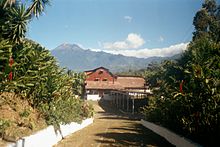- Coffee production in Guatemala
-
The coffee production in Guatemala is important for the Guatemalan economy. While until recently it was Central America's top producer of coffee, the coffee production in Honduras surpassed Guatemala in 2011.[1] However, it must be noted that there are also illegally exports to Honduras and Mexico and earnings from illegal trade are not reflected in the official statistics.[2]
Geography
The most suitable temperature for the healthy growth and abundant production of coffee in Guatemala is that of 60° to 90° F. In lands situated at an altitude of 500–700 metres (1,600–2,300 ft) above sea level, young plants must be shaded. In zones averaging an altitude of 1,500 metres (4,900 ft), the plantations must be sheltered from the cold north winds. For the most part, the coffee plantations are situated at an altitude varying from 500–5,000 metres (1,600–16,000 ft) above sea level. [3]
History
The coffee industry began to develop in Guatemala in the 1850s and 1860s, initially mixing its cultivation with cochineal. Small plantations flourished in Amatitlán and Antigua areas in the southwest.[4] Initial growth though was slow due to lack of knowledge and technology. Many planters had to rely on loans and borrow from their families to finance their coffee estates (fincas) so coffee production in the country grew increasing non-Guatemalan, owned by foreign companies who possessed the financial power to buy plantations and provide investment.[4]
The scarcity of laborers was the main obstacle to a rapid increase of coffee production in Guatemala. In 1887, the production was over 48,500,000 pounds; in 1891, it was over 52,000,000 pounds. From 1879 to 1883, Guatemala exported 293,274,971 pounds of coffee. By 1902, the most important coffee plantations were found in the southern coast. Many acres of land were suitable for this cultivation, and the varieties that were produced in the temperate regions were superior. Coffee was grown around Guatemala City, Chimaltenango, and Verapaz. The majority of the plantations were located in the departments of Guatemala, Amatitlan, Zacatepeques, Solola, Retalhuleu, Quezaltenango, San Marcos, and Alta Vera Paz.[3]
References
- This article includes text incorporated from Pan American Union's "Coffee: extensive information and statistics" (1902), a publication now in the public domain.
- ^ Guerrero, Jean (July 29, 2011). "A Prince of the Coffee Bean Honduras Becomes Central America's Top Producer, Helping to Fuel Its Economy". The Wall Street Journal. http://online.wsj.com/article/SB10001424053111904800304576474211973637364.html. Retrieved 16 November 2011.
- ^ Information Services on Latin America (Oakland, Calif.) (January 1986). ISLA. I.S.L.A.. http://books.google.com/books?id=GLwvAQAAIAAJ. Retrieved 20 November 2011.
- ^ a b Pan American Union (1902). Coffee: extensive information and statistics (Public domain ed.). Govt. Print. Off.. pp. 21–. http://books.google.com/books?id=yvYaAAAAYAAJ&pg=PA21. Retrieved 16 November 2011.
- ^ a b Clarence-Smith, W. G.; Topik, Steven (2003). The global coffee economy in Africa, Asia and Latin America, 1500-1989. Cambridge University Press. p. 191. ISBN 978-0-521-81851-3. http://books.google.com/books?id=xMkTK9Vi62wC&pg=PA191. Retrieved 20 November 2011.
Coffee Topics - Economics
- Fair trade
- Health effects
- History
Production by
countrySpecies and
varietiesMajor
componentsProcessing Preparation Popular
beverages- Affogato
- Americano
- Bicerin
- Cà phê sữa đá
- Café au lait
- Café con leche
- Café Cubano
- Cafe mocha
- Caffè corretto
- Caffè macchiato
- Cappuccino
- Carajillo
- Coffee milk
- Cortado
- Espresso
- Flat white
- Frappuccino
- Galão
- Greek frappé coffee
- Iced coffee
- Indian filter coffee
- Ipoh white coffee
- Irish coffee
- Kopi Luwak
- Latte
- Latte macchiato
- Liqueur coffee
- Long black
- Red eye
- Ristretto
- Turkish coffee
Substitutes Lifestyle  Guatemala topics
Guatemala topicsHistory Pre-Columbian history • Spanish Conquest • New Granada • Captaincy General • Federal Republic of Central America • 1954 Guatemalan coup d'état • Guatemalan Civil War (1960-96) • 1976 Guatemala earthquake
Politics Elections • Political parties • Constitution • Foreign relations • Military • Law enforcement • Congress • Presidents • Supreme Court • Human rights • International rankingsGeography Environmental issues • Fauna • Flora • National parks • Subdivisions (Departments • Cities • Municipalities) • World Heritage SitesEconomy Agriculture • Communications • Companies • Currency • Energy • Science and technology • Stock exchange • TransportDemographics Crime (Illegal drug trade) • Education • Healthcare • Immigration • Languages • Religion • Notable Guatemalans • Indigenous peoplesCulture Cuisine • Cinema • Guatemalan Spanish • Heritage • Holidays • Internet domain • Literature • Media • Music • SportSymbols WikiProject • PortalCategories:- Economy of Guatemala
- Agriculture in Guatemala
- Coffee production by country
Wikimedia Foundation. 2010.


